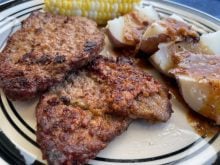Our growing season on the Prairies is so short. Plant too early and Jack Frost will get it – leave it too long and he’ll get it in the fall. It’s a guessing game and every year is different. With rain forecast, a rare commodity in our area, and late May, I decided it was time to put the seeds in the ground.
The grandkids had told me they buried a little shovel in the garden. I watched for it while rototilling and planting, but it didn’t surface. The next day they decided they should find the shovel and return it to me. With shovels in hand, they laboriously dug around, and still didn’t find it. What they didn’t know was that seeds had been planted where they were digging.
Read Also

AgriStability updates offer stronger support for farmers
One of the most significant updates to the AgriStability program for the 2025 program year is the increase in the compensation rate.
In a small town garden it doesn’t take long for two small children to cover a fairly large piece of the garden. It will be interesting to see what grows and where.
Will potatoes like being cozied up to beets, cucumbers with lettuce or corn with carrots? I said every year was different.
Melons and food safety
Before cutting a cantaloupe, watermelon or other melons, wash it to remove surface dirt and bacteria. Use cool running water and a scrub brush.
Food poisoning from salmonella has been linked to melons. If the unwashed rind is contaminated, the knife can drag the bacteria into the fruit, or your hands can spread them.
Refrigerate cut melon. It can be left unrefrigerated at a buffet or picnic for up to two hours, and then should be discarded.
At markets, buy cut melon only if refrigerated; it shouldn’t merely sit on top of ice. Unlike most fruit, melons are not acidic, so bacteria can thrive on them when they are cut up and not kept cold.
Oreo mini cheesecakes
Place 12 paper liners in muffin tins. Set an Oreo cookie on the bottom of each muffin liner.
Beat together three 8 oz. (250 g) packages of softened cream cheese and 3/4 cup (175 mL) sugar until smooth. Add three eggs, one at a time and mix until just blended. Spoon over each cookie.
Bake at 350 F (180 C) for 15-20 minutes or until centre is almost set. Cool completely, then refrigerate one hour or overnight. Drizzle with melted chocolate and a dollop of whipped topping.
For a smaller cheesecake, I found reducing the amount of filling by a third still made a nice sized dessert. To do that, use two 8 oz. (250 g) packages of cream cheese, 1/2 cup (125 mL) sugar and two eggs instead of the amounts listed in the recipe. Servings: 12.
Source: Kraftcanada.com
Don’t forget that cheesecakes can become a good place for bacteria to grow. If taking cheesecake to a picnic, cook it well enough in advance so it can be adequately cooled to 40 F (4 C) before you leave home. They may also be frozen for added protection.
Transport in the air-conditioned part of the vehicle, away from direct sunlight, in a cooler with ice or freezer packs. Keep refrigerated until ready to serve. Do not leave at room temperature for more than two hours. After that time throw away leftovers. It’s better to be safe than sorry.
For more information or any concerns on food safety, contact the Alberta Food Safety Info Line at 800-892-8333, or visit www.foodsafetyline.org.
Unusual liquid
Dear TEAM: Could you tell me how to use a product – Cortas tahina, 100 percent stone ground sesame? It’s a product of Lebanon. It is still sealed but is very liquid. I’m hoping it can be used in cookies or muffins. Any recipes would be gratefully appreciated, or can this be used in place of cooking oil in any recipes I already have?
Now to tell you why I bought this: I collect those Kraft peanut butter bear jars. I’ve got some here that don’t have lids and one particular size has an odd sized lid. This sesame product jar lid will fit and I need two lids.
I don’t collect these jars as an antique but to use on my open shelves in my kitchen. I spray the lids all the same shade of green so they match each other.
Also, to update your files about Regal Ware pot handles. Factory Outlet Appliance in Edmonton has closed recently and the Orangeville, Ont., place is also gone.
I’ve just ordered from Wisconsin over the phone with Visa and the lady told me her company is the only one now in business. Call 800-832-5932. -E.S., Morinville, Alta.
Dear E.S.: Thanks for your Regal Ware information.
Cortas tahina is an oily nut flavoured paste made from 100 percent ground sesame seeds, as your jar label states. Cortas is the company name and it says that when it makes tahina “the seeds are hulled, roasted and stone ground.”
Tahina is used in many recipes as well as in confectionery foods in Middle Eastern cuisine. Some examples are in hummus, moutabel and baba ghanoush. These are dips for Arabian breads and chips. Hummus is a puree of chickpeas, tahina, lemon juice and garlic; moutabel is an eggplant dip made with olive oil, tahina and lemon juice; and baba ghanoush is a puree of char-grilled eggplant, tahina, olive oil, lemon juice and garlic.
A popular sauce is the tarator made of tahina, salt, lemon juice and water to get a slightly fluid consistency. This sauce can be added to many dishes with meat, fish, vegetables and other foods. Tahina is added to carob molasses to make a delicious highly nutritious dessert.
It is used as a base for halawa, a crumbly, melt-in-your-mouth, ready-to-eat confection. It can be an ingredient in salad dressings and added to bean salads.
You could try adding the tahina flavour to some of your favourite sauce, salad or dip recipes. You might like to obtain recipes from a Middle Eastern cookbook at a library or bookstore. Here is one recipe I found on the internet.
Hummus recipe using tahina
3-4 large cloves of garlic
1 can (14-19 oz.) 398-540 mL
drained chickpeas
1 lemon, freshly squeezed
1 tablespoon salt 15 mL
1 tablespoon black pepper 15 mL
2 tablespoons mayonnaise 30 mL
11/2 teaspoons paprika 7 mL
pinch of cayenne pepper
1/4-1/2 cup water 60-125 mL
(add for desired thickness)
1/4 cup tahina (to taste) 60 mL
2 tablespoons of extra virgin 30 mL
olive oil
Place garlic in food processor with a little water to help get a fine purée.
Place all other contents (except water and tahina) in food processor and process for 20-30 seconds.
Slowly add water as you purée the mix. Continue adding water until the desired thickness is reached. Add tahina to taste.
Serve at room temperature with a light splash of olive oil on top as a dip for Arabian bread or your favourite chips and crackers.
Source: www.steveandlori.com/Recipes/hommos.htm.
Folklore contest
Ninety days after a fog it will rain. Is that a folklore tale you believe in? If you have a folklore tale you would like to share, send it to us at TEAM Resources Folklore Contest, Box 2500, Saskatoon, Sask. S7K 2C4.
The deadline for entries is June 24. If you are concerned about the mail meeting the deadline, e-mail to team@producer.com.
You could win a copy of Company’s Coming new Most Loved Main Courses or Atco Gas Blue Flame Kitchen’s Romancing the Flames Cookbook.
Alma Copeland is a home economist from Elrose, Sask., and one of four columnists comprising Team Resources. Send correspondence in care of this newspaper, Box 2500, Saskatoon, Sask., S7K 2C4 or contact them at team@producer.com.














